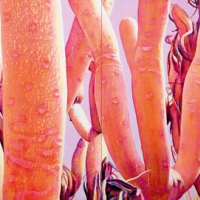40. TIM MAGUIRE

The winner of the 1993 Moet and Chandon Fellowship, Tim Maguires work came to prominence as a research project into the effects of light on paired water tanks. He had already been immersed in theoretical developments through Art history studies at the University of Sydney and later at East Sydney Technical College, but in 1985 an Australia Council scholarship presented an opportunity to engage with the most recent ideas by enrolling at the Dsseldorf Academy in Germany. The intellectual character of this venerable art School at that time was strongly flavoured by the towering presence of Joseph Beuys and his contemporaries and a succeeding generation which included figures such as Anselm Kiefer, Blinky Palermo, Sigmar Polke, Gerhard Richter and George Baselitz. Dsseldorf and the neighbouring city of Cologne was at that time a world hub of all the latest developments in contemporary art. Maguire had placed himself in the equivalent of Manets Paris, and Florence in the age of Raphael.
At the same time, Maguire had easy access to some of the worlds most important collections of Old Master paintings as well as some of the best collections of Post World War II American art outside the USA. The importance of this exposure becomes clear when we examine the paintings that emerged from his studio in the coming years. The independence of thought, awareness of tradition, utilisation of science (in Maguires case as it relates to the process of painting) and seriousness of approach are all hallmarks of the group of artists operating in the sphere of Beuys influence. Maguire uses banal objects transformed through selective illumination and re-scaling to create monumental Art. Ironically, Dsseldorf precipitated Maguires engagement with his home. Australia is referenced through an object no less culturally loaded than the corrugated iron water tank. These were aggressively aesthetisized through this process into monoliths. Enlargement becomes a means of re-assessment. Distortion of scale recalls the work of American op art as well as pop-arts, and in particular the work of Chuck Close. The results refresh our experience of the New York School minimalist Barnett Newman.
Later Maguire drew on appropriation theory to explore the means by which The Old Masters, mostly Dutch 17th century Still Life painters expressed a world view through a vase of flowers. By selecting and blowing up a detail of an old painting, to the point where the original is beyond recognition, Maguire creates the paintings which brought him to international prominence, and which form the most recognisable part of his work today.
These extraordinarily seductive works recall, in appearance as well as in approach, Vermeer. Both artists construct paintings of comparatively grounded subject matter, where the content of the painting exists alongside the artists interest in light, optics, texture and colour. The intense quality in Vermeers paintings arises from integrating so many and varied visual concerns in a plausible tableau. The masters of Still-Life painting walk a path between beauty and luxury as a collectible object for the delight of a connoisseur, on one hand, with strict and rigorous adherence to the formal mechanism of art, with reference to notions of mortality and the concept of vanitas as a philosophical underpinning, on the other. The niceties of a contradiction between an objects appearance and its meaning are revisited in Maguires paintings.
In Maguires work the broad compositional swathes as well as prismatic crevices and folds of the subjects, where light refracts through an organic surface or through moisture are integrated through the use of solvents and glazes. Visually these works are finished, or framed by the use of Maguires distinctive splash technique, which leaves a random patterning of blotches and bubbles across the composition. The technique of simultaneously selecting, focussing, recomposing, enlarging, extraction of colour and distortion through the finishing process was later refined. The use of Old Masters as a source material has now given way to photography of actual vegetation.
Notwithstanding Maguires engagement with art theory and history, or perhaps because of it, the paintings he produces are significantly beautiful. They are carefully positioned in todays art market by his continued residence in Europe. Although he is best known through representation by leading contemporary galleries in Australia (Tolarno in Melbourne and Martin Browne in Sydney) he is also well known elsewhere through a program of regular exhibitions in England, Europe and America.
Timothy Abdallah